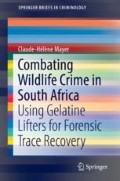Abstract
This chapter serves as an introduction to the study on combating wildlife crime in South Africa within the context of green criminology. A case study investigation into the use of gelatine lifters for forensic trace recovery is presented. It provides first insights into the topic through an introduction to the field of study. The book further guides the reader through the theoretical approaches of green criminology and wildlife crime (combat), the research methodology, problem statement, purpose, aims and contributions. Finally, an overview of the structure of this study is given and the chapter closes with a summary.
Access this chapter
Tax calculation will be finalised at checkout
Purchases are for personal use only
References
Ayling, J. (2013). What sustains wildlife crime? Rhino horn trading and the resilience of criminal networks. Journal of International Wildlife Law & Policy, 16, 57–80.
Brisman, A., South, N., & White, R. (2016). Environmental crime and social conflict. New York: Routledge.
Eman, K., Mesko, G., & Fields, C. B. (2009). Crimes against the environment. Green criminology and research challenges in Slovenia. Journal of Criminal Justice and Security, 11(4), 574–592.
Lunstrum, E. (2014). Green militarization: Anti-poaching efforts and the spatial contours of Kruger National Park. Nature and Society, 104(4), 816–832.
Lynch, M. J., & Stretesky, P. B. (2014). Exploring green criminology: Toward a green criminology revolution. Farnham: Ashgate.
Lynch, M. L., Long, M. A., Stretesky, P. B., & Barrett, K. L. (2017). Green criminology. Crime, justice and the environment. Oakland, CA: University of California Press.
Moreto, W. D., & Pires, S. F. (2018). Wildlife crime. An environmental criminology and crime science perspective. Durham, NC: Carolina Academic Press.
Morgan, R. M., Wilfshire, P., Parker, A., & Bull, P. A. (2006). The role of forensic geoscience in wildlife crime detection. Forensic Science International, 162(1–3), 152–162.
Nellemann, C., Henriksen, R., Raxter, P., Ash, N., & Mrema, E. (2014). The environmental crime crisis: Threats to sustainable development from illegal exploitation and trade in wildlife and forest resources. Nairobi, Kenya: UN Environment Programme.
Schmidt, H. (2013). Ein grüner Zweig der Kriminologie. Überlegungen zur green criminology. Kriminologisches Journal, 45(4), 260–278.
South African Development Community. (2015). Law enforcement and anti-poaching strategy. Retrieved from: http://www.gaborone.diplo.de/contentblob/4715602/Daten/6225475/SADC_LEAP_FINAL.pdf
South, N. (2010). The ecocidal tendencies of late modernity: Transnational crime, social exclusions, victims and rights. In R. White (Ed.), Global environmental harm: Criminological perspective (pp. 228–247). Devon: William Publishing.
South, N., & Wyatt, T. (2011). Comparing illicit trades in wildlife and drugs: An exploratory study. Deviant Behaviour, 32(6), 538–361.
UNDP. (2017). Strengthening legal frameworks to combat wildlife crime. Symposium Report: Africa-Asia Pacific Symposium, Bangkok, 4–5 July 2017 – United Nations Inter-agency task force on illicit trade in wildlife and forest products. http://www.undp.org/content/undp/en/home/librarypage/environment-energy/ecosystems_and_biodiversity/strengthening-legal-frameworks-to-combat-wildlife-crime.html
Wellsmith, M. (2011). Wildlife crime: The problems of enforcement. European Journal on Criminal Policy ad Research, 17(2), 125–148.
White, R., & Heckenberg, D. (2014). Green Criminology. An introduction to the study of environmental harm. Oxon: Routledge.
Wilson-Wilde, L. (2010). Wildlife crime: A global problem. Forensic Science, Medicine and Pathology, 6, 221–222.
Wyatt, T. (2009). Exploring the organization of Russia Far East’s illegal wildlife trade: Two case studies of the illegal fur and illegal falcon trades. Global Crime, 10(1–2), 144–154.
Author information
Authors and Affiliations
Rights and permissions
Copyright information
© 2019 The Author(s), under exclusive license to Springer Nature Switzerland AG
About this chapter
Cite this chapter
Mayer, CH. (2019). Introduction. In: Combating Wildlife Crime in South Africa. SpringerBriefs in Criminology. Springer, Cham. https://doi.org/10.1007/978-3-030-05891-3_1
Download citation
DOI: https://doi.org/10.1007/978-3-030-05891-3_1
Published:
Publisher Name: Springer, Cham
Print ISBN: 978-3-030-05890-6
Online ISBN: 978-3-030-05891-3
eBook Packages: Law and CriminologyLaw and Criminology (R0)

